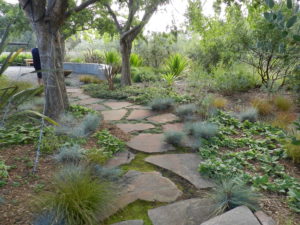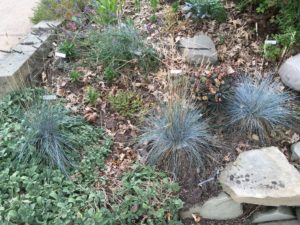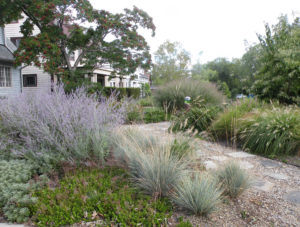As I mentioned at an earlier time, ornamental grasses are the epitome of low maintenance – one scything in early spring.

Festuca and Sesleria autumnalis in naturalistic setting
The exceptions to the spring scything rule are two of the blue grasses, i.e. Festuca (Blue Fescue) and Helictotrichon (Blue Oat Grass). These grasses should never be pruned. If there are dead leaves, they should be gently removed with gloved fingers (remember that grass foliage has sharp edges).
There are many shades of blue but steel blue epitomizes the blue grasses. Festuca and Helictotrichon have similar textures and forms, spiky and stiff, as well as narrow, delicate panicles but they vary in size. Helictotrichon could be a fescue on steroids. Good drainage is the key to their survival, particularly during hot, wet summers although we rarely have that type of weather here in Ohio. Lately, our summers have been hot and dry.

Color echo of bluestone and Festuca at Floriade 2012

Festuca ‘Cool as Ice’ in west hill
There are three main species of Festuca, all of which are frequently confused and difficult to tell apart but they are so similar that it really doesn’t matter whether it is F.cinerea, F.glauca or F.ovina but all are hardy to zone 4.. All three grow six to eighteen inches tall and wide and are clumpers. The older selections were seed grown and thus vary enormously in the depth of color. Newer selections from Europe are grown from division and should continue to be propagated that way in order to retain the special color of each cultivar. Festuca ’Elijah Blue’ is probably the best known, has soft blue leaves and seems to survive better than many of the other cultivars but a new introduction from Intrinsic Nursery, ‘Cool as Ice’, has been undaunted in my garden these past two years by the drought.
Plants often look best if the inflorescences are sheared back after blooming. It looks quite good when combined with other plants that love sunny, dry conditions and good drainage such as the upright sedums and Yucca filamentosa.

Helictotrichon as specimen in my west perennial border
While Festuca looks best as a mass, one Helictotrichon has enough presence to be used as a specimen. I have grown it in a gravel/sand/humus mix where it has survived for many winters. There are a few cultivars, the most noteworthy of which is ‘Sapphire’ but I see little difference between it and the species although it supposedly has better rust resistance. I have planted mine along the edge of the driveway with Stachys monieri ‘Hummelo’ and Monarda ‘Dark Ponticum’. The steel blue foliage and its linearity provide excellent textural and color contrast.

Helictotrichon massed with Perovskia, Ajania pacificum, Sedum ‘Angelina’, Pennisetum, and Panicum in Cleveland Heights front yard xeriscape
Helictotrichon is a native of the western Mediterranean and also hardy to zone 4. It grows two to two and a half feet high and wide. While some of the leaves turn brown during the winter, many retain their blue color.
Since repetition is one of the keys to unifying a border, both grasses could be used as a color echo of each other. Plant Festuca in groups of three or more at the front of the border as the end pieces and perhaps again in the middle and plant some Helictotrichon in the midborder. You could then contrast these splashes of blue with drifts of green foliage and /or yellow foliage. The list is endless but some suggestions are Aster divarictus (White Wood Aster), Coreopsis verticillata (Threadleaf Tickseaed), one of the green-leafed Dianthus, Stachys byzantina ‘Primrose Heron’, or Origanum onites ‘Aureum’ (Golden Oregano).
When you want year-round color, remember the blue grasses.


2 Comments